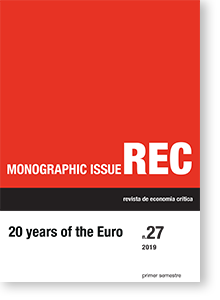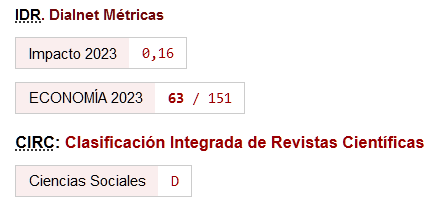The euro at twenty: Follies of youth?
Palabras clave:
Euro crisis, banking union, Eurozone, austerity strategy, fiscal rulesResumen
This paper overviews the early history of the euro and argues that the euro was sub-optimally designed, without monetary sovereignty of Eurozone (EZ) Member States, in order to comply with political goals set by wealthier Member States. Given this constraint, the euro architects designed a single currency in which its irreversibility is achieved through the EZ banking system, with recourse to the TARGET2 payment system. This allowed the banking systems of deficit Member States to fund large cumulative current account deficits in the first decade of the euro. The euro crisis led EZ policy makers to define new far more demanding fiscal rules and a new Banking Union to constrain the ability of EZ banking systems to fund sovereigns and current account deficits. As a result, the euro at twenty has become more fragile.
Descargas
Citas
Alesina, A. (2010): "Fiscal adjustments: Lessons from recent history". Paper prepared for the ECOFIN meeting in Madrid, 15 April.
Alesina, A. and S. Ardagna (2010): "Large changes in fiscal policy: Taxes versus spending". Tax Policy and the Economy, 24, pp. 35-68.
https://doi.org/10.1086/649828
Alesina, A., R. Perotti, and J. Tavares (1998): "The political economy of fiscal adjustments". Brookings Papers on Economic Activity, pp. 197-266.
https://doi.org/10.2307/2534672
Andini, C. (2008): "Portugal and the competitive disinflation: Let the data speak". Economics Bulletin, 6, pp. 1-11.
Andini, C., R. Cabral, and F. Louçã (2016): "A policy response to the intra-Eurozone crises". Working paper.
Atkins, R. and M. Schieritz (2005): "ECB targets its problem nations", Financial Times, 9 November.
Avgouleas, E. and C. Goodhart (2015): "Critical reflections on bank bail-ins". Journal of Financial Regulation, 1, pp. 3-29.
https://doi.org/10.1093/jfr/fju009
Baldwin, R. and F. Giavazzi (2015): "Towards a consensus on the causes of the EZ crisis". Voxeu.org, 7 September.
Blanchard, O. (2007): "Adjustment within the euro. The difficult case of Portugal". Portuguese Economic Journal, 6, pp. 1-21.
https://doi.org/10.1007/s10258-006-0015-4
Blanchard, O., M. Griffiths, and B. Gruss (2013): "Boom, bust, recovery: Forensics of the Latvia crisis". Brookings Papers on Economic Activity, 44, pp. 325-388.
https://doi.org/10.1353/eca.2013.0015
Blanchard, O., and P. Muet (1993): "Competitiveness through disinflation: An assessment of the French macroeconomic strategy". Economic Policy, 8, pp. 11-56.
https://doi.org/10.2307/1344567
Blyth, M. (2013): Austerity: The history of a dangerous idea. New York: Oxford University Press.
Bofinger, P. (2018): "'Black zero' in disguise". VoxEU.org, 13 September.
Brennan, J. (2017): "Central Bank sells further €500m of bonds linked to Anglo Irish bailout", The Irish Times, 15 June.
Buchheit, L. and M. Gulati (2010): "How to restructure Greek debt". Duke Law Working Papers. Paper 47.
https://doi.org/10.2139/ssrn.1603304
Buiter, W. and A. Sibert (2005): "How the Eurosystem's treatment of collateral in its open market operations weakens fiscal discipline in the eurozone (and what to do about it)". CEPR Discussion paper 5387.
Buti, M. and V. Gaspar (2008): "The first ten years of the euro". VoxEU.org, 24 December.
Cabral, R. (2012): "The roots of the euro crisis lie at the doorsteps of the ECB". Roubini's EconoMonitor, 1 October.
Cabral, R. (2013): "O euro em crise: Cronologia e análise". In: Palma, C., E. Paz Ferreira, and H. Torres, eds., Estudos em Homenagem ao Professor Doutor Alberto Xavier, Vol. II, Coimbra: Almedina, pp. 635-654.
Cabral, R. (2018): "The Eurozone banking union: Rationale and early experience". Working paper.
Cesaratto, S. (2013): "The implications of TARGET2 in the European balance of payments crisis and beyond". European Journal of Economics and Economic Policy: Intervention, 10, pp. 359-382.
https://doi.org/10.4337/ejeep.2013.03.09
Cesaratto, S. (2015a): "Balance of payments or monetary sovereignty? In search of the EMU's original sin - comments on Marc Lavoie's The Eurozone: Similarities to and differences from Keynes's plan". International Journal of Political Economy, 44, pp. 142-156.
https://doi.org/10.1080/08911916.2015.1060830
Cesaratto, S. (2015b): "Alternative interpretation of a stateless currency crisis". Cambridge Journal of Economics, 41, pp. 977-998.
https://doi.org/10.1093/cje/bew065
Ching, S. and M. Devereux (2003): "Mundell revisited: A simple approach to the costs and benefits of a single currency area". Review of International Economics, 11, pp. 674-691.
https://doi.org/10.1111/1467-9396.00410
Chowdhury, A. (2012): "Revisiting the evidence on expansionary fiscal austerity: Alesina's hour?" VoxEU.org, 28 February.
Aquí está la bibliografía con saltos de línea:
Damásio, B., F. Louçã and J. Nicolau (2018): "The changing economic regimes and expected time to recover of the peripheral countries under the euro: A nonparametric approach". Physica A: Statistical Mechanics and its Applications, 507, pp. 524-533.
https://doi.org/10.1016/j.physa.2018.05.089
Gelpern, A. and M. Gulati (2013): "The wonder-clause". Journal of Comparative Economics, 41, 367-385.
https://doi.org/10.1016/j.jce.2013.03.009
de Grauwe, P. (2008): "On the need to renovate the Eurozone". International Finance, 11, pp. 327-333.
https://doi.org/10.1111/j.1468-2362.2008.01227.x
de Grauwe, P. (2013): "Design failures in the Eurozone: Can they be fixed?" LEQS Paper No 57/2013.
https://doi.org/10.2139/ssrn.2215762
de Grauwe, P. and Y. Ji (2013): "Panic-driven austerity in the Eurozone and its implications". Voxeu.org, 21 February.
Febrero, E., J. Uxó, and F. Bermejo (2018): "The financial crisis in the Eurozone: A balance-of-payments crisis with a single currency?" Review of Keynesian Economics, 6, pp. 221-239.
https://doi.org/10.4337/roke.2018.02.04
Issing, O. (2008): The birth of the euro. Cambridge: Cambridge University Press.
Jespersen, J. (2004): "The Stability Pact: A macroeconomic straitjacket!" In: Ljungberg, J., ed., The price of the euro, London: Palgrave Macmillan.
https://doi.org/10.1057/9780230523807_3
Lavoie, M. (2015): "The Eurozone: Similarities to and differences from Keynes's plan". International Journal of Political Economy, 44, pp. 3-17.
https://doi.org/10.1080/08911916.2015.1035980
Louçã, F. and J. Amaral (2014): A solução novo escudo. Lisboa: Lua de Papel.
McKinnon, R. (2002): "Mundell, the euro, and optimum currency areas". In: Courchene, T., ed., Money Markets and Mobility, Kingston, Ontario: John Deutsch Institute for the Study of Economic Policy.
Otero-Iglesias, M. (2017): "Italy's struggle with the euro straitjacket". LSE European Politics and Policy (EUROPP) Blog, 16 February.
Sachs, J. and F. Larrain (1999): "Why dollarization is more straitjacket than salvation". Foreign Policy, 116, pp. 80-92.
https://doi.org/10.2307/1149645
Sinn, H.-W. (2011): "The ECB's stealth bailout". VoxEU.org, 1 June.
Sinn, H.-W. and T. Wollmershäuser (2011): "Target loans, current account balances and capital flows: The ECB's rescue facility". CES ifo Working Paper No. 3500.
https://doi.org/10.3386/w17626
Stiglitz, J. (2016): The euro: How a common currency threatens the future of Europe. New York: W. W. Norton & Company.
Descargas
Publicado
Cómo citar
Número
Sección
Licencia
Esta licencia permite a terceros compartir (copiar y redistribuir el material en cualquier medio o formato) y adaptar (remezclar, transformar y crear a partir del material para cualquier finalidad, incluso comercial), siempre que se reconozca la autoría y la primera publicación en esta revista (La Revista, DOI de la obra), se proporcione un enlace a la licencia y se indique si se han realizado cambios en la obra.







